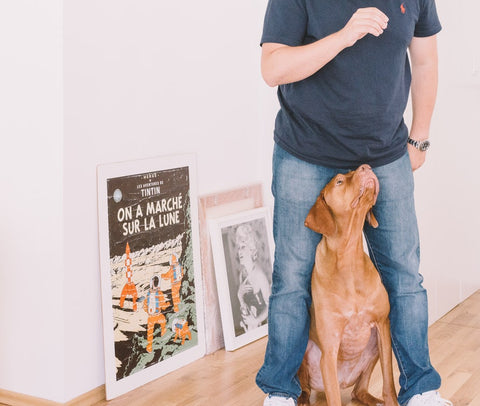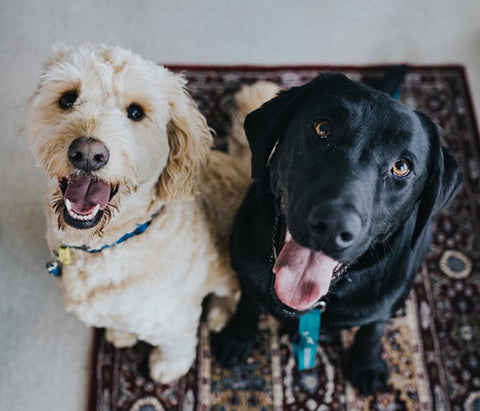
Dogs have been by our sides throughout history. The first evidence of humans domesticating dogs dates back over 36,000 years ago.
Dogs have been bred for hunting, tracking, working, shepherding, and companionship throughout the years. Today there are over 80 million dogs in the United States!
Creature Feature: Dogs (Canis Lupus Familiaris)
Today, most dogs are companion animals, and they have had time to perfect their wagging tails and happy nuzzles when their humans come home. They have been by our sides throughout history, pulling carts, herding sheep and other animals, working as sled dogs, and tracking animals during a hunt.
Some dogs still perform these tasks; all dogs get satisfaction out of pleasing their humans through some kind of work, even if that's performing tricks on command and acting as the perfect foot warmer on a rainy day.

There is a dog for everyone! In cities and smaller spaces, compact dogs that do not require huge amounts of hard exercise can be a better fit. For farms, having sheepdogs that have herding bred into their lineage can be important.
There are many reputable shelters in Portland to adopt dogs from, such as the Multnomah County Animal Shelter, Oregon Humane Society, Pixie Project, One Tail at a Time, and many other local rescues. If you are looking for a specific breed, finding a reputable local breeder can be a great way to find a healthy puppy, or checking search engines such as "Petfinder.com", where you can often find breed specific rescues.
Ask for copies of your dog's complete medical records and plan a vet visit within the first few weeks of having them. For puppies, they will often need a set of vaccines before going in public and being around other dogs.
Check out our Puppy-12-x-12 guide for ideas of new and positive experiences your dog should have within the first few months of coming home with you!
Housing Requirements
Home Prep:
Dogs are curious by nature so when bringing a dog into the home it is important to prepare for their arrival. Remove any temptation of food, medicine, and choke-able objects from within your dog's reach.
 Use baby-proof locks to keep cabinets secure, cover/lock trash cans, and block any small spaces, nooks, and areas behind places such as couches or washing machines (that way they won’t wiggle themselves into getting stuck). Many plants can be toxic to dogs, so make sure none are accessible for them to munch on. Take a look at this useful guide to make sure all the plants in your home are safe for them.
Use baby-proof locks to keep cabinets secure, cover/lock trash cans, and block any small spaces, nooks, and areas behind places such as couches or washing machines (that way they won’t wiggle themselves into getting stuck). Many plants can be toxic to dogs, so make sure none are accessible for them to munch on. Take a look at this useful guide to make sure all the plants in your home are safe for them.
Ordinary items such as shoes, socks, clothing, any electric cords, and other small items should always be out of reach.
Puppies are still babies and have different needs than adult dogs. They require a more consistent feeding schedule, age and size-specific pet toys, and they should be closely supervised--especially in the first few weeks of being in their new home.
Take a look at the KONG chew toy specifically designed for puppies below! It can be a great way to keep them busy and entertained when they are alone.
Introducing a pet to your home should be done in a calm environment to prevent any additional stress. Keep interactions calm, positive, and always allow the dog or puppy to have an escape route should they become overwhelmed.
If two or more pets will be sharing the home, introduce them slowly and in a neutral zone (for instance, introduce two dogs on leash).
To crate or not to crate?
Crates act as a dog's den. They are safe places for them to retreat to for bedtime, relaxing during the day, and they can be confined within them when you are out of the house and unable to supervise them.
Dogs should never be crated for more than 6 hours at a time and should always have access to water and soft bedding. Crates should not be used in a negative way, such as punishment or confinement. They should be large enough for your dog to sit, stand, lie down, and turn around in.
Most crates come with a movable divider so you can make the space larger as a puppy or young dog grows. By keeping the space tighter, it allows them to feel more cozy and secure!
Necessary Supplies
- Food (a complete and balanced diet)
- Treats
- Food and water bowl
-
Toys
- Chewy toys (squeakers, crinkly toys, balls)
- Treat/kibble balls
- Soft plush toys
- Rope toys (great for “flossing” your dog's teeth!)
- Collar with ID tags
- Leash
- Harness
- Crate
- Soft or hard carrier
- Enzymatic/biological cleaner
- Bed or crate liner
- Preventative flea treatment
- and of course, Poop bags
Download our complete shopping list and check off items as you go!
Feeding
Dogs are omnivores and thrive on meat-based, moderate protein diets. There are many food options for dogs, ranging from kibble to raw food.
Every dog has different requirements, and different foods have different benefits. Most foods are formulated for 'adult' dogs (over 1 year) or for 'All Life Stages' which means it can be fed to puppies through senior dogs.
Puppy foods are often higher in fat and calcium to ensure your pup is getting all the calories they need to grow! Senior foods tend to be lower in fat and higher in fiber to keep a less active dog trim.
Dogs should be fed twice per day, so you should break suggested serving sizes into two portions. Try to vary the times you feed your dog - that way they will not come to expect being fed at a certain time. This will prevent them from begging for food, but feeding at the same time can also cause their body to build up stomach acids in preparation.
If at that point the feeding time changes, it can cause acid reflux and stomach upset.
Rotational diets have many different health benefits (if the dog has no allergies or sensitivities to certain proteins). By varying the protein in their food whenever you finish a bag, you will keep their metabolism from settling.
Exposing them to different types of proteins builds their immune system and may prevent food sensitivities later in life.
Kibble is a convenient way to feed a complete and balanced diet, but it is not the only option! Canned food or re-hydrated/frozen raw foods are a great way to add moisture to your dog's diet and have many health benefits of their own. Ask one of our staff if you have any questions about finding the best food for your dog!
Grooming
Depending on your dog's breed, they will have different grooming needs.
All dogs should be brushed at least weekly, and most dogs can be brushed with a bristle or pin brush to remove any mats or tangles. For dogs with no undercoat such as terriers or poodles, a slicker brush will not tangle in their coats but will remove knots and mats and leave their coats smooth.
Mats can be harmful to a dog's health and are uncomfortable when they are pressed against their skin.
De-shedders work to remove the undercoat of a dog so they have less hair to shed. De-shedders should not be used for longer than 15 minutes at a time and no more than three times per week (never use them on puppies). They will not work on 'single-coat' dogs such as terriers or poodle mixes.
Dogs should be bathed monthly at most. Their coats contain natural oils that keep them healthy and shiny. Excessive bathing will dry out their coats. Puppies should be shampooed minimally - their coats are already puppy soft!
Training and Socializing
Training classes are beneficial for both your dog and for you as well! Techniques on training and working with your dog are great to learn, and it also helps bond you and your dog. Socializing your dog with other people and dogs is another huge benefit of puppy/training classes. Check out our puppy training guide for more info on how to choose the best class for you and your pup.

Socializing with your dog is important to keep them healthy. Dogs are people pleasers and enjoy learning new tricks and tasks.
Walking your dog is both physically and mentally stimulating for them. Sniffing new scents, seeing new things, and getting to know their territory is exciting for them, and you may see new things in your own neighborhood too!
Signs of a healthy dog:
Here are some signs of a healthy dog:
- Skin is smooth and hydrated; free of redness, scabs, growths and rashes.
- Coat is glossy, without dandruff or any areas of hair loss.
- Eyes are bright and free of discharge.
- Ears on the inside should be light pink, clean, not swollen, and free of discharge.
- Nose should be moist with no cracks or dryness.
- Temperature should be 100 to 102.5 degrees.
- Stools should be firm and consistent.
- You should be able to feel their ribs, but not see them. If you cannot feel their ribs while applying gentle pressure, your dog may be overweight.
Red Flags
This is a short list of some health warning signs. As a dog owner, it is up to you to determine differences in your dog's behavior and heed warning signs of sickness. Always bring your dog to the veterinarian if you think they might be ill.
- Significant changes in behavior (i.e. increased irritability, lethargy, loss of appetite)
- Visible pain (limping, chewing on a joint, whining)
- Persistent vomiting or diarrhea
- Excessive urination (short frequent bursts, discomfort while urinating, urinating in unusual places)
- Excessive drinking
Fun Facts!
-
A house, two cars, and the dog...62% of United States households have at least one pet dog. That's 72.9 million homes!
-
Strong sniffers...dog noses possess 300 million olfactory receptors (compared to 6 million in humans). This means their sense of smell is almost 1 million times greater than ours!
-
Running down a dream...dogs dream just like we do! They have the same type of slow wave sleep (SWS) and rapid eye movement (REM) and dream in their REM stage. They may twitch, move their paws, or even look like they're running in place while dreaming.
- Night vision goggles...dogs’ eyes contain a special membrane, called the tapetum lucidum, which allows them to see in the dark.
-
Workin' dogs...work has always been a part of the dog and human relationships. They've been herding, pulling, and tracking for centuries. Today dogs have added to their resume: working as guide animals, therapy dogs, they can be trained to monitor different medical conditions; some are search and rescue animals, and some dogs are even actors!

- No sweat...dogs do not sweat, they pant instead! Most of their heat escapes through their belly and paw pads. If they get hot in the summer months, giving them a frozen towel to lie on can cool them right down.



